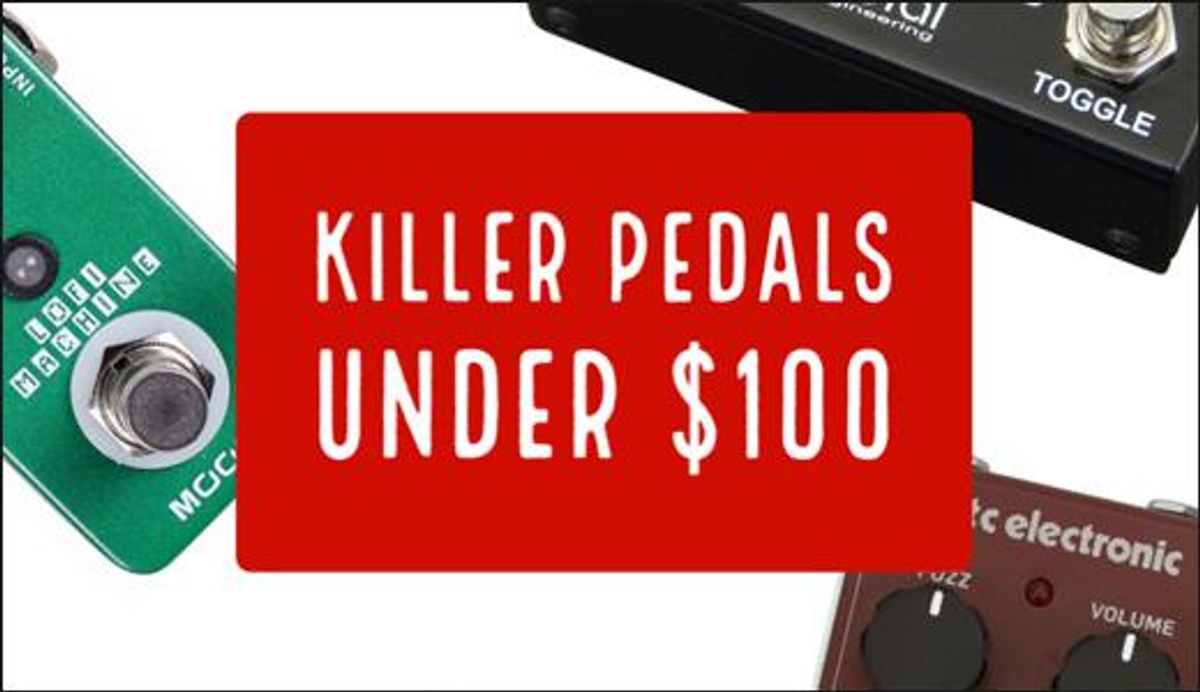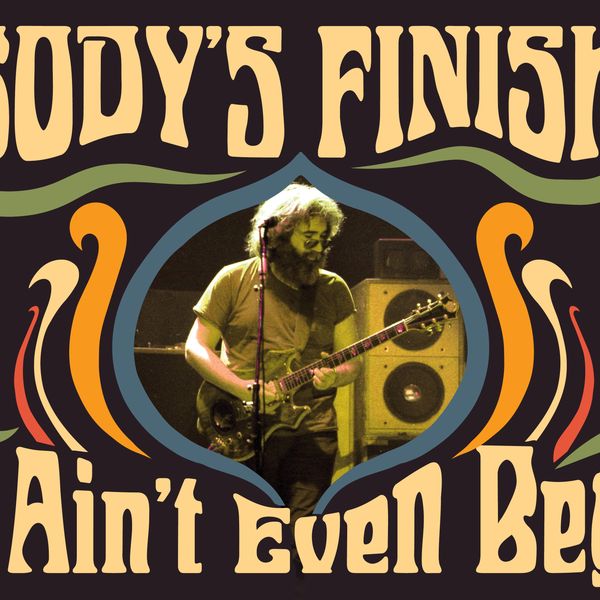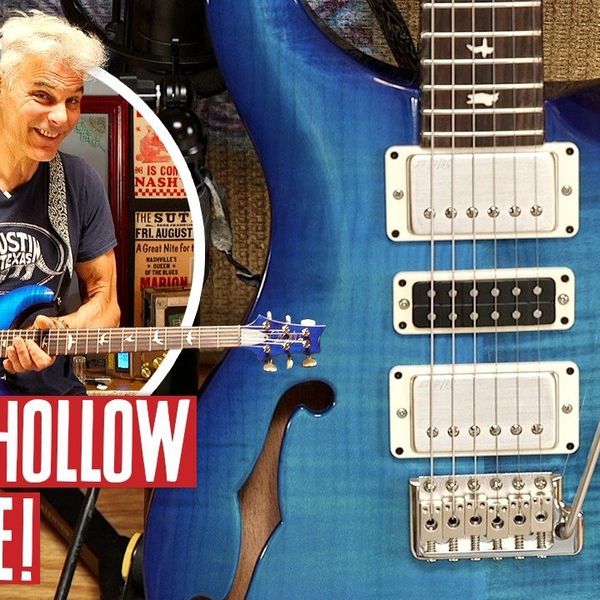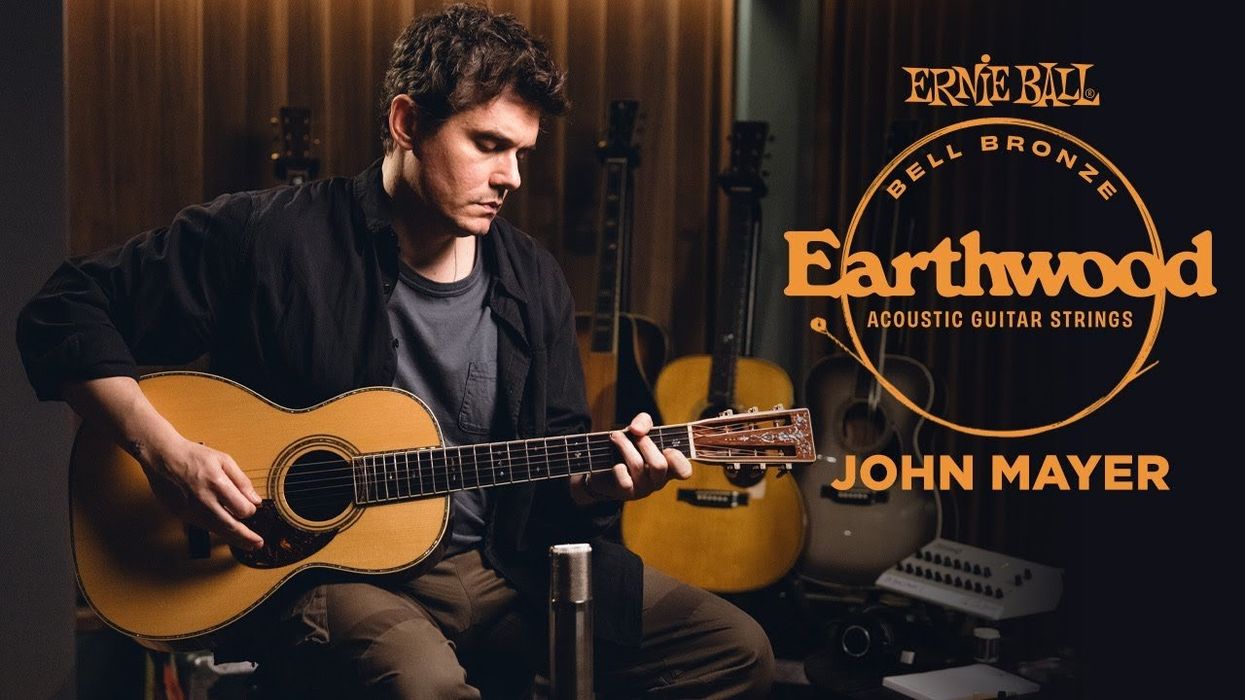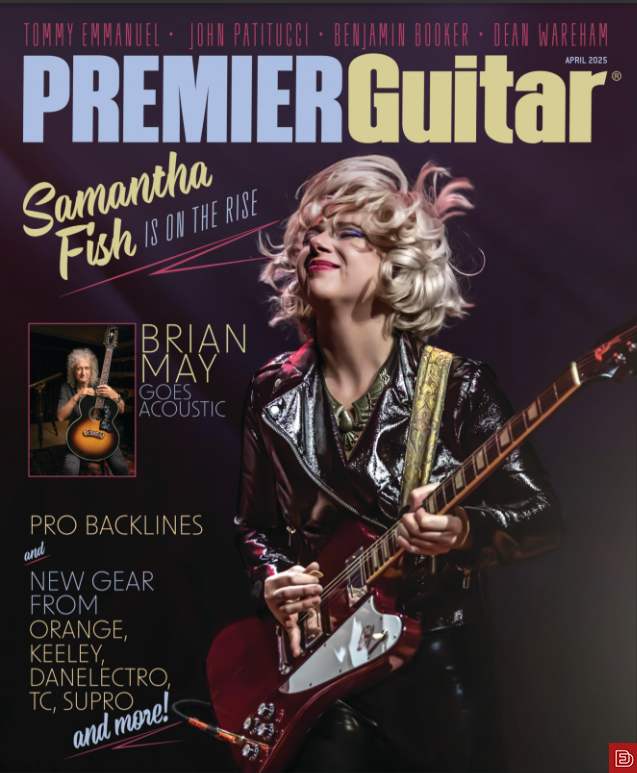PG editors pick their favorite pedalboard-tested bargain stomps—tremolos, dirt boxes, tuners, switchers, and more.
The past year's record gear sales tell us that pandemic window shopping has become more a passion than a pastime. And whether you're pushing a “buy" button or on the horn to your local music shop, pedals are among the most affordable jones satisfiers. Our editors compared notes—and their own pedalboards—to compile this list of our favorite stomps that provide a big tonal bang for under a Benny. They range from time-proven classics to thoroughly modern mojo machines. Check it out, and at these prices you don't even have to hide your wallet first.
TC Electronic Rusty Fuzz

Many modern Fuzz Face-inspired silicon circuits are too dark and mannered, but this badass bargain zeroes in on a joyful range of anarchic, retro tones, from Hendrix to Big Brother. With unity gain at about 10 o'clock, keeping the fuzz setting under 11 a.m. provides enough hair to sting, and levels above that are slap-your-mama. Floor the fuzz and it's '68 at the Fillmore—held notes sing with feedback and bent strings roar and fluctuate, eventually decaying in a beastly groan. Even with fuzz maxed, the tone dial is quite responsive, so highs needn't get drowned in the tidal wave of fur, and turning the tone all the way down warms things if desired. And with a maximum output gain of +55 dB, punching through a live mix is not an issue. The Rusty Fuzz oxidizes the sound of humbuckers at every setting, although it takes some cranking to drive single-coils to glorious ruin. Add a wah pedal and cock it to different positions to tap some truly dinosauric sounds. There's no 9V battery option, but there is enough dynamism and control to satisfy any breed of vintage raunch hound. —Ted Drozdowski
The Good: Easily controllable, super-authentic-sounding vintage fuzz at a bargain price.
The Bad: No 9V option.
$69 street, tcelectronic.com
'93 Gibson Les Paul Classic, neck humbucker, GarageBand reverb plug-in; Rusty Fuzz off, then, volume at unity with fuzz at noon, 3 o'clock, and maxed, with tone at noon; next, fuzz at noon, 3, and 5 o'clock with tone maxed.
Mooer Trelicopter

From Origin Effects' and MXR's latest tremolo wonders to other time-proven gems, there's no shortage of cool amplitude-undulators on the market. But what I've long loved about the Trelicopter is that it puts remarkably amp-like tremolo at your feet not just for a ridiculously nice price, but also in a miniscule package. Even better, whereas many more expensive trem stomps tend to sacrifice faster, choppier sounds for slower, super-chill vibes (or vice versa), Trelicopter hovers in a wonderful middle ground. This is largely thanks to its handy bias control, which sharpens or smooths waveform edges to simulate sounds ranging from black- to brown-panel-esque. —Shawn Hammond
The Good: Vintage-feeling amp trem in a tiny package that's more flexible than many more expensive stomps.
The Bad: Seems to very slightly sap treble frequencies. Mini pots lack indicator mark.
$88 street, mooeraudio.com
Nobels ODR-Mini

It's not a stretch to think that aspiring session guitarists come to Nashville packing a Tele, a capo, and this overdrive. This mini version of the cult classic keeps the general vibe of its larger sibling along with its beautifully rich and mid-focused sound. Thanks to session player Tom Bukovac, the Nobels has taken on a life of its own—to the point where Buk' had to make a video busting all the myths around his early history with it, right down to the $30 price tag. Once word got out about the ODR, it landed on every Nashville cat's board and prices for vintage ones started to rise. Naturally the gain and level controls are self-explanatory, but the real magic is in the spectrum knob. Unlike a typical tone control, the spectrum moves several different frequencies around at the same time. Turning it counter-clockwise gives the tone a mid hump, but not in the way you might think. It decreases the bass and treble—a very handy feature when you're trying to find the right guitar/amp/pedal combo in a mix. If you dig the whole TS vibe but want more mid control, start with this other green box. —Jason Shadrick
The Good: Glow-in-the-dark knobs! You can run it at 18V for more headroom.
The Bad: At extreme gain settings it gets a bit fizzy.
$79 street, nobels.de
Korg Pitchblack Custom

For what's arguably the most important pedal on the floor, this tuner appeals to the type of player who—alongside quickness and accuracy—puts high value on visibility to counteract dark stages and/or sub-par vision. Its 3-D, liquid-like screen makes up about 75 percent of the face of the pedal and leaves no doubt as to what's on the display, no matter which of the four different meter modes chosen. In terms of accuracy, you'd be hard pressed to do much better than the Pitchblack Custom's +/- 0.1 cent spec, unless you pony up for a desktop strobe unit. You won't find a big menu of tuning presets, polyphonic functionality, or other ancillary features on the true-bypass Custom, but it's wonderfully simple and fast, and caters to people like me who can never find their glasses. It's just icing on the cake that the sub-$100 box happens to look like a stealthy spy gadget. —Rich Osweiler
The Good: Huge, crisp, and clear display. Minimalist design. Accuracy to +/- 0.1 cents.
The Bad: Nada.
$99 street, korg.com
Boss TR-2 Tremolo
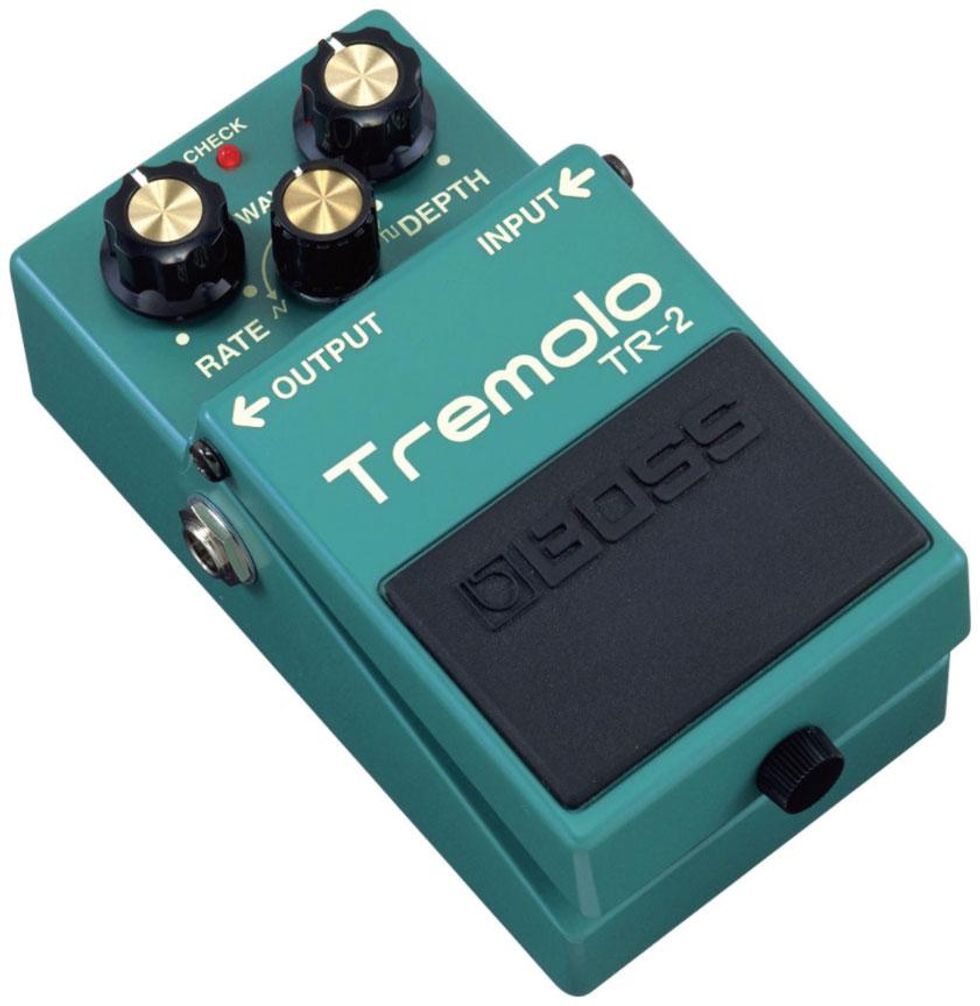
This list is supposed to be about pedals less than 100 bucks. But at $103 and change, we've made an exception for the venerable and perpetually overachieving TR-2. I bought mine more than a decade ago (I think it was then priced closer to $129), stuck it on my board, and, with a few exceptions, it's been there ever since. Does it top the sounds of vintage Fender amp trems, or one of the more exacting (and expensive) new-school DSP-vintage-driven emulations? No, but I tend to find the comparisons academic. The TR-2 has a warm but familiar voice all its own—several actually, when you factor in the waveform control, which moves from soft, round sine-wave pulses to choppier square waves, and many blends in between. The TR-2 has quirks, like a depth control that makes the modulation virtually imperceptible until just before high noon on the dial. But the perceived volume drop that allegedly plagued early models is long gone, And like so many Boss pedals, it's built to sturdy standards that rival much more expensive and exclusive boutique offerings. —Charles Saufley
The Good: Great range of tremolo textures, from soft, soulfully undulating pulses to hard-choppin' square waves.
The Bad: Not much perceptible modulation in the first half of the depth control's range
$103 street, boss.info
MXR Blue Box
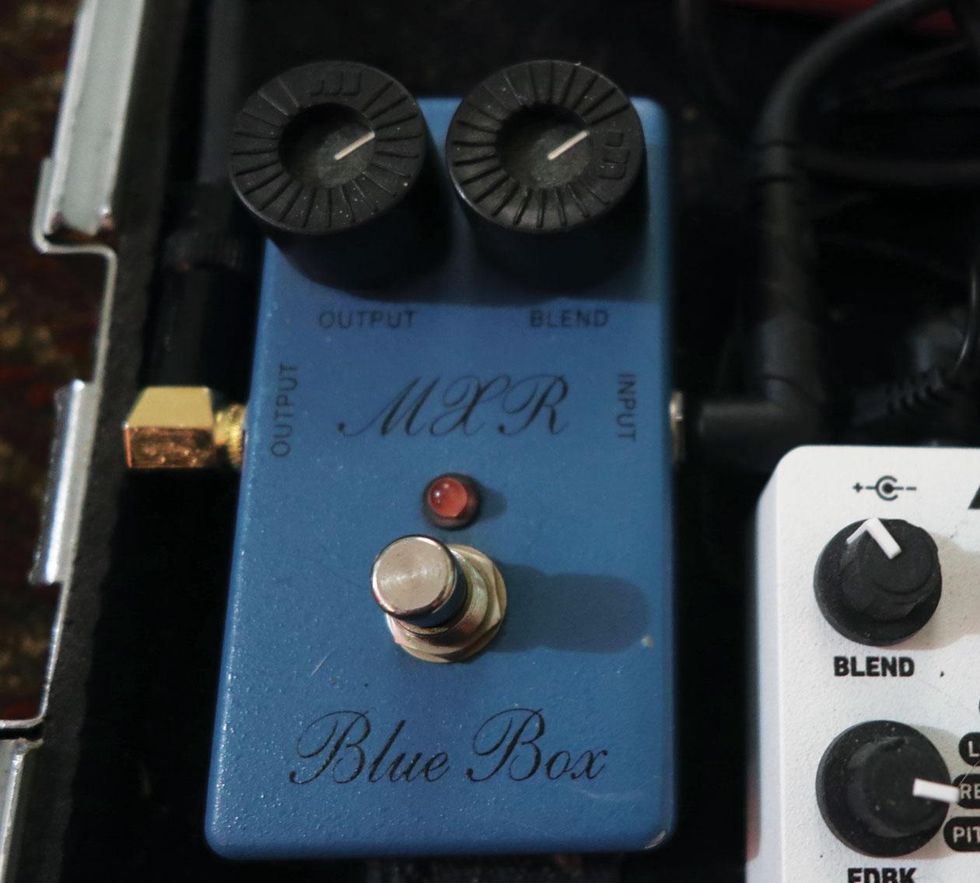
This two-octaves-down-plus-fuzz stomp has been creating chaos since 1974, although it took Jimmy Page's solo on 1979's "Fool in the Rain" to really put it on the map. Today, the pedal's making a well-deserved comeback in stoner rock. It's a simple critter—the double-octave drop engages when it's switched on, the output controls volume, and blend adds or subtracts fuzz. Counterintuitively, with more fuzz in the mix, the overall sound is more controllable and sustained, and less glitchy. Same thing when you play higher on the neck. But the low octave tones are full of marvelously colorful blips and snorts, and the unpredictable note decay—sometimes it's more like dropping off a cliff—has a stellar charm all its own. Try a chord, for a laugh. If that unpredictable decay becomes annoying, just zip a clean boost in front of the Blue Box to beef up sustain. But half the fun of this venerable device—which works on 9V battery or adaptor power—is that madcap unpredictability. —TD
The Good: A Pagey-approved, distinctively weird-ass sound for the ages.
The Bad: If glitching and unpredictable drop-outs bug you, this one-trick horsie ain't your ride.
$79 street, jimdunlop.com
'93 Gibson Les Paul Classic, neck humbucker, Carr Vincent combo, Blue Box off, output at unity; then Blue Box on with blend at 7, 9, 12, and 3 o'clock, and maxed. Followed by a G campfire chord clean, and then with blend at max and at 3 p.m.
Radial Engineering BigShot ABY
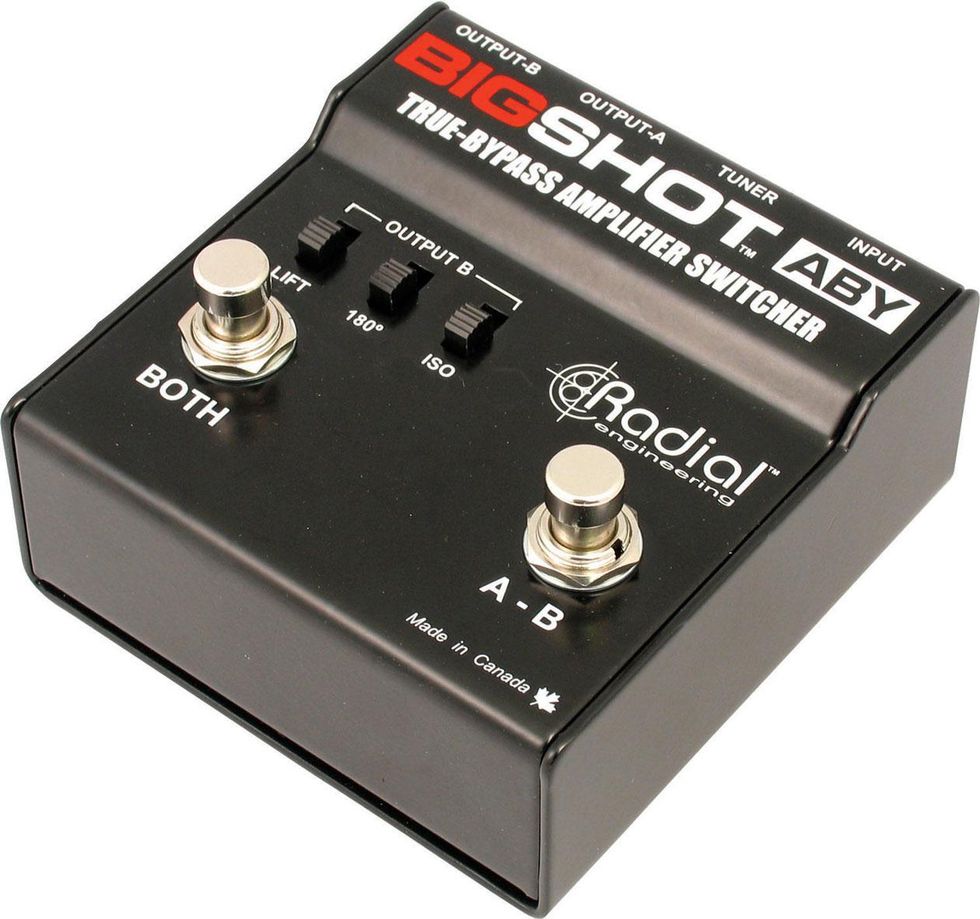
If you ever get the hankering to see how fun/cool it is to play through or switch between two amps, just keep in mind it's not quite as simple as just tracking down a box that lets you send your mono signal to two outputs. As many players have found the hard way, phase-cancellation and ground-loop goblins lurk in the shadows of such setups, so if your junction box doesn't have features to deal with them, you may be prematurely thrown off your game and wonder "What the hell! These amps sound fantastic on their own—why don't they now?" In our Rig Rundowns, you've no doubt seen innumerable professionals using Radial utilities for unexciting-but-critical concerns such as these. That's because Radial gear is super sturdy and typically addresses all possible gigging downfalls with straightforward simplicity. For instance, the BigShot ABY requires no power (unless you want to power the current version's channel-indicator LEDs—mine is an older one without LEDs, but I keep the amps on full-time so it doesn't matter) and features a slider for correcting that weak, nasal sound you get when your amps are out of phase, as well as ground-lift and isolation-transformer switches to help eliminate hum. Even cooler, while Radial might not encourage it, I've had wonderful luck using the BigShot's tuner output to route my signal to a third amp, sans any phasing or noise issues. —SH
The Good: Smart, superb, no-nonsense way to play through two or three amps.
The Bad: NA
$99 street, radialeng.com
ProCo RAT 2

We see a lot more RAT 2 homages from boutique builders these days. That's a welcome development, because the RAT 2's basic architecture and tone profile has always been more versatile than its heavy reputation suggests. Good RATs can make leads liquid and white hot with sustain. They also generate great low- to mid-gain overdrive tones, and the filter/tone knob can crate thick, smoky fuzz and distortion voices. But one of the best things about the RAT 2 is that the contemporary China-built version—which sells for a whopping $70—still gets you most of the way to the sound of a vintage late-'80s/early-'90s version. I had one of these recent RATs on extended loan from a pal. It lacked some of the mysterious, hazy thickness and complexity that my vintage version delivers at heavily filtered, attenuated-highs settings. It can also seem a bit peaky in the top end compared to my battered oldie. But 95 percent of the time—and especially in those growling mid-gain distortion settings that folks love to hear from a RAT—the recent-vintage unit sounded and felt practically indiscernible. Did I get lucky? Maybe. But it seems more likely that after selling about a zillion RAT 2s, Pro Co has sorted out how to build this classic to consistently high standards on the cheap. —CS
The Good: Almost all of the killer sounds you'd get from a vintage RAT 2. Super inexpensive.
The Bad: Filtered tones can lack some of the complexity heard in vintage versions.
$70 street, ratdistortion.com
TC Electronic Hall of Fame 2 Mini
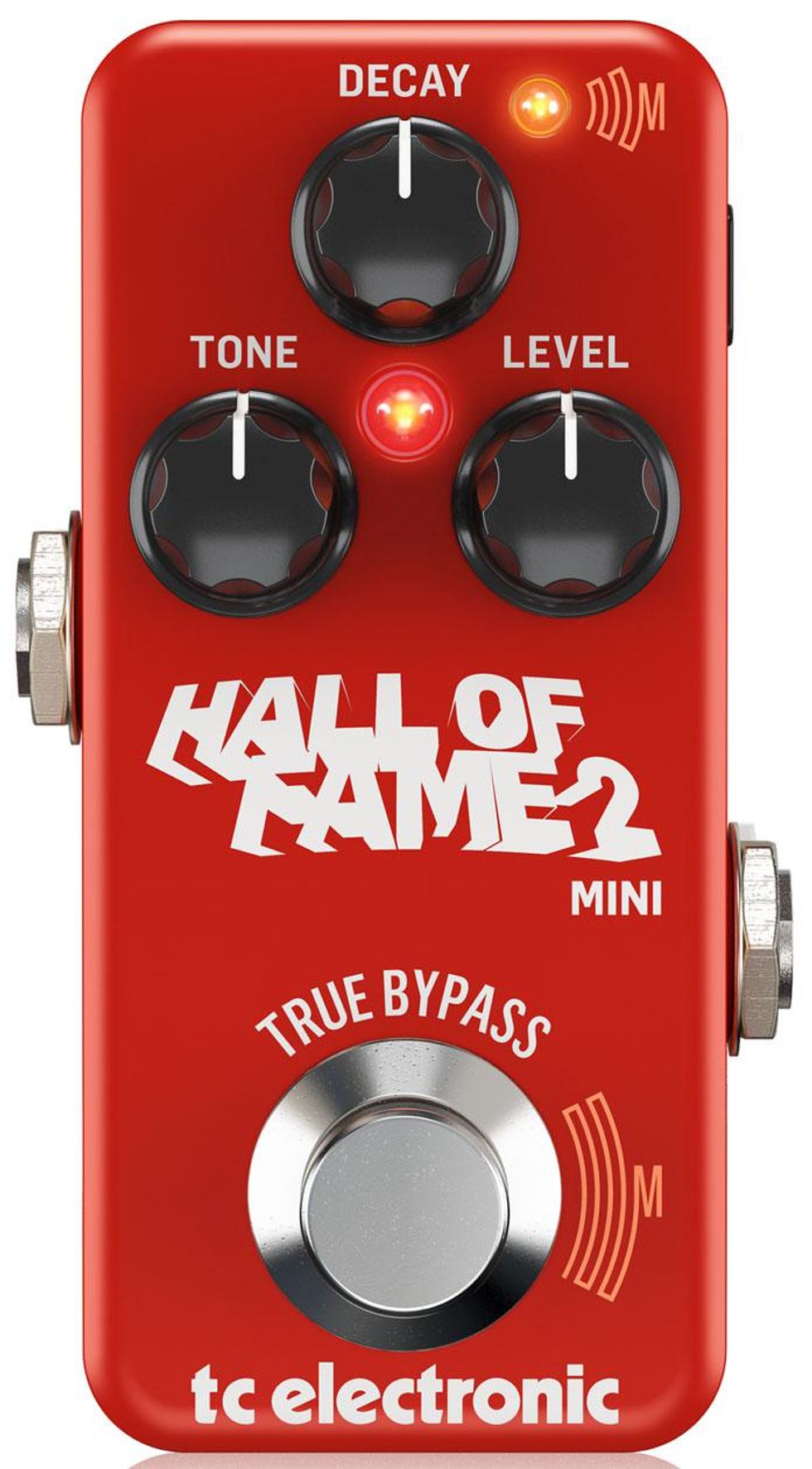
Emulating the sound and feel of space is one of the most enduring and strangely satisfying musical effects for guitarists. From the drippy goodness of vintage Fender combos to the ethereal and metallic sounds of modern shimmer, various types of reverb are close to rivaling the number of 3-knob overdrives. The Hall of Fame 2 Mini is a tiny little stomp that covers nearly any possible reverb flavor you might need. When I first got my hands on one, I needed more of a set-and-forget for times when I had a reverb-less backline. Admittedly, I also spent a fair amount of time just blissfully exploring the more ambient settings. One significant upgrade over its predecessor is the addition of a MASH footswitch that acts as an expression pedal to give certain settings more real-time depth and dynamics. You can really interact with the tones in a meaningful way by simply pressing down a bit more. In most cases the effect is subtle but present. However, with a bit of deeper editing via the TonePrint app, you can get downright Fripp-esque with it. If anyone asks about a reverb pedal but doesn't have an affinity toward a particular flavor, I point them to the HOF 2. —JS
The Good: Mind-boggling amount of control via the app. Very authentic analog sounds.
The Bad: Not easy to switch reverb types on the fly.
$99 street, tcelectronic.com
TC Electronic Hall of Fame 2 Mini - Pedals Under $100
Electro-Harmonix Stereo Pulsar

Pulsar is a space-age-sounding name for a decidedly retro analog pedal, and its ability to toggle between triangle and square waves is common to other tremolo stomps, as is the shape dial that adds adjustable sawtooth characteristics to the triangle mode and variable pulse widths to the square wave mode. Rate and depth are the other controls, naturally. So, what makes this box special? It's a stereo tremolo for under $100, and if you think that's not a big deal it's only because you haven't experienced the psychoacoustic payoff of on/off square wave pulses ricocheting between a pair of amps—and your eardrums. It's an enjoyably trippy experience, as the pulses gently and intermittently slap the sides of your skull. But triangle mode shines, too, in a smoother way. Slow pulses of moderate depth also blend well with chorus, phasing, flanging, and even carefully tailored delay-pedal settings, so there's room for more sonic deviance. Use the main out only, and the pedal's mono, giving your amp classic Fender-style tremolo sounds. Add in 9V battery and adaptor power options, and a hard metal shell that's likely bulletproof, and you've got a workhorse stomp that dabbles in microdosing.—TD
The Good: Honest vintage tremolo that's easily shapeable and, in stereo, trippy as hell.
The Bad: If you're looking for modern twists like shimmer and layering, this ain't your juice box.
$89 street, ehx.com
Sample 1 — Round Waves: '73 Fender Stratocaster, Carr Vincent combo and Orange Micro Terror head and Sam Hill Custom 1x12 cabinet, Pulsar off, then with shape control at 10, 12, and 2 o'clock; depth at noon except last play-through at 2
Sample 2 — Triangle Waves: '73 Fender Stratocaster, Carr Vincent combo and Orange Micro Terror head and Sam Hill Custom 1x12 cabinet, Pulsar off, then with shape control at 10, 12, and 2 o'clock; depth at noon except last play-through at 2
Mooer Lo-Fi Machine

My first crack at trying a Mooer came when I reviewed the LoFi Machine nearly seven years ago. Initially, I was skeptical because of the brand's super-low prices and newness on the scene, but it didn't take long to forget all that. The bit knob reduces sampling depth from 5–16 bits, while mix and sample control dry/wet ratio and sample-rate reduction (60–31,250 Hz), respectively, and a 3-way toggle optimizes EQ response for synth, guitar, or bass. With careful manipulation of these controls (as well as your picking attack and other effects), you can use the Machine to summon everything from cool vintage electric-piano approximations to harpsichord tones and old-school video game sounds. Needless to say, I bought this rad stompbox after the review, and today it's still part of my rig—only at the moment it sits atop my keyboard, where I can easily manipulate controls with one hand while playing with the other. —SH
The Good: Myriad unusual sounds—from tame and lovely to lovably silly or sadistically warped—in a small, affordable package.
The Bad: Slightly saps treble frequencies. Mini-pot settings difficult to keep track of.
$98 street, mooeraudio.com
Test Gear: Danelectro '56 Baritone reissue, Squier Vintage Modified Telecaster Custom with Curtis Novak pickups, Schecter Ultra III with TV Jones Magna'Tron bridge pickup, Jaguar HC50 and Goodsell Valpreaux 21 amps.
EarthQuaker Devices Plumes

The ubiquity of the Tube Screamer—and the scores of overdrives that have come in its wake—make it easy to forget the virtues and potential of the original. In fact, EarthQuaker Devices founder Jamie Stillman once hinted he would never bother with building a TS-based pedal. But EQD is nothing if not a restless bunch, and I suspect that the challenge of building a TS-inspired circuit with variable clipping—all for 99 bucks—was more than Stillman and crew could resist. The results are impressive. In general, the Plumes has a bit more headroom and clarity in the top end than your average TS. The LED symmetrical clipping mode ranges to savage grinding and beautifully compressed. The asymmetrical clipping mode is a little softer around the edges, with almost-saturated Fender-amp-like overdrive. There's also a no-clipping op-amp boost setting that reminds you how effectively a TS can work as a near-clean boost. Plumes would be a great TS alternative if it were 50 to 70 percent more expensive. At this price, it's a steal. —CS
The Good: A TS with a triple twist of clipping options. Great range of aggressive-to-clean sounds. Great tone control. More headroom than your average TS-style pedal.
The Bad: Hard to switch clipping modes on the fly without major volume changes.
$99 street, earthquakerdevices.com
Kliq TinyTune

When it comes to mini tuner pedals, mainstream brands like TC Electronic, D'Addario, and Korg tend to rule the roost for serious players, but does that mean they're our only viable option? I decided to put that question to the test a couple years ago when my old Planet Waves Chromatic Pedal Tuner finally died and I saw all the great Amazon reviews for the KLIQ TinyTune. As you've probably noticed, shopper reviews—whether on Amazon or a respected retailer's site—are often overly fawning simply because the item arrived quickly, the sales consultant was engaging and friendly, or, most offensively, the person didn't encounter any problems after using the product for an hour or two. Nevertheless, with an average rating of 4.5 and hundreds upon hundreds of reviews, I figured $29 wasn't that big a gamble. When the TinyTune arrived, I was pleasantly surprised to find that it seemed every bit as sturdy and feature-laden as other tuners on the market, and its display was both brighter and less jumpy than many tuners I've used. —SH
The Good: Excellent build quality and feature set. Clear, bright, easy-to-read interface.
The Bad: Registers notes slightly slower than more expensive offerings.
$29 street, kliqmusicgear.com
Electro-Harmonix Nano Bass Big Muff
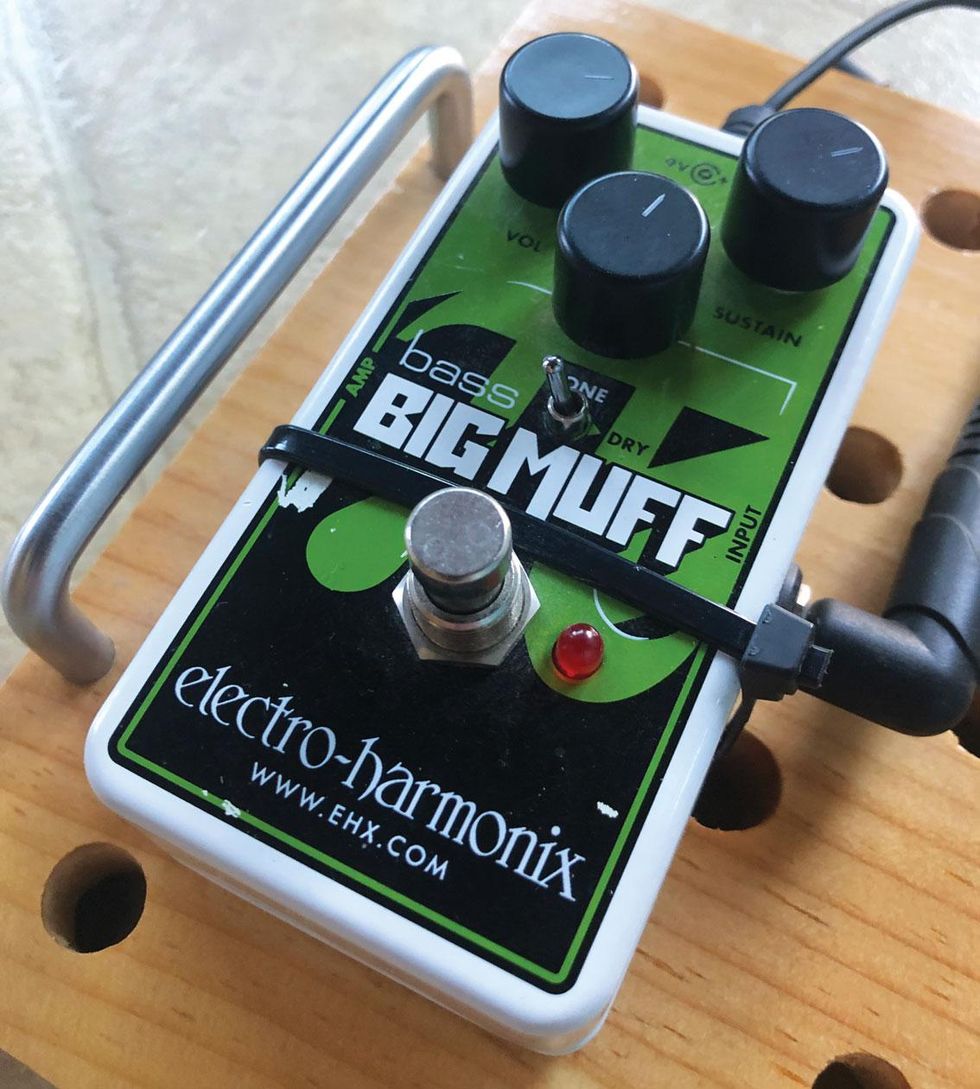
Electro-Harmonix is known for a lot of things, with distorted tones and affordability way up high on that list. Inspired by the company's lauded green Russian Big Muff, but in a smaller package and voiced for bassists, the Nano Bass Big Muff houses the accustomed volume, tone, and sustain dials for sound sculpting. However, this Muff also has a mini toggle to switch over to a 50/50 wet/dry signal blend and assist in low-end retention and clarity. At just about 80 bucks, the price is certainly nice, but so is its dirt delivery, which leans more towards warm and fat as opposed to a treble-y or harsher timbre. The NBBM's range of thick fuzz tones are apt for stoner and doom to vintage rock and metal, and really pushing it will spit out copious amounts of tummy tickling fuzz with synth-y flavor, but the NBBM also hangs nicely as a foundational tool with just a kiss of dirty in dry mode. There are a lot of great fuzz pedals for bassists on the market, but pound for pound divided by price, the Nano Bass Big Muff is pretty close to Nobrainerville for me. —Rich Osweiler
The Good: Excellent low-end retention. Dry switch for wet/dry blend.
The Bad: Wet/dry blend limited to the toggle switch's preset 50/50 ratio.
$80 street, ehx.com
Electro-Harmonix Bass Big Muff Nano - Pedals Under $100
MXR CSP101SL Script Phase 90

Maybe it's just front of mind because of Edward Van Halen's recent passing, but when the idea for this story first came across my desk, I immediately flashed on "Eruption" and went to see what a Phase 90 was going for. Thankfully, this Custom Shop version squeaked right under our dollar parameters. The thick syrupy sounds of a well-crafted phaser have permeated not only some of EVH's most famous jams, but also the outlaw funk of Waylon Jennings and the reggae jams of Bob Marley. For the orange-box purists, the script logo versions are the way to go. Thankfully, this particular model has both an LED and an option for 9V power—both of which are missing in the original model. With only one knob to control the speed, the lack of tweakable options is freeing, in a way. Simply turn it until it sounds good. Many times I find myself using my foot to dial in just the right amount, thanks to the handy rubber ring that MXR throws in the box. This is easily one of trippiest pedals to stand the test of time. —JS
The Good: Dead simple to use. Sounds fantastic.
The Bad: I probably use it too much.
$99 street,jimdunlop.com
MXR CSP101SL Script Phase 90 - Pedals Under $100
Big Knob Tone Blender MkII 66
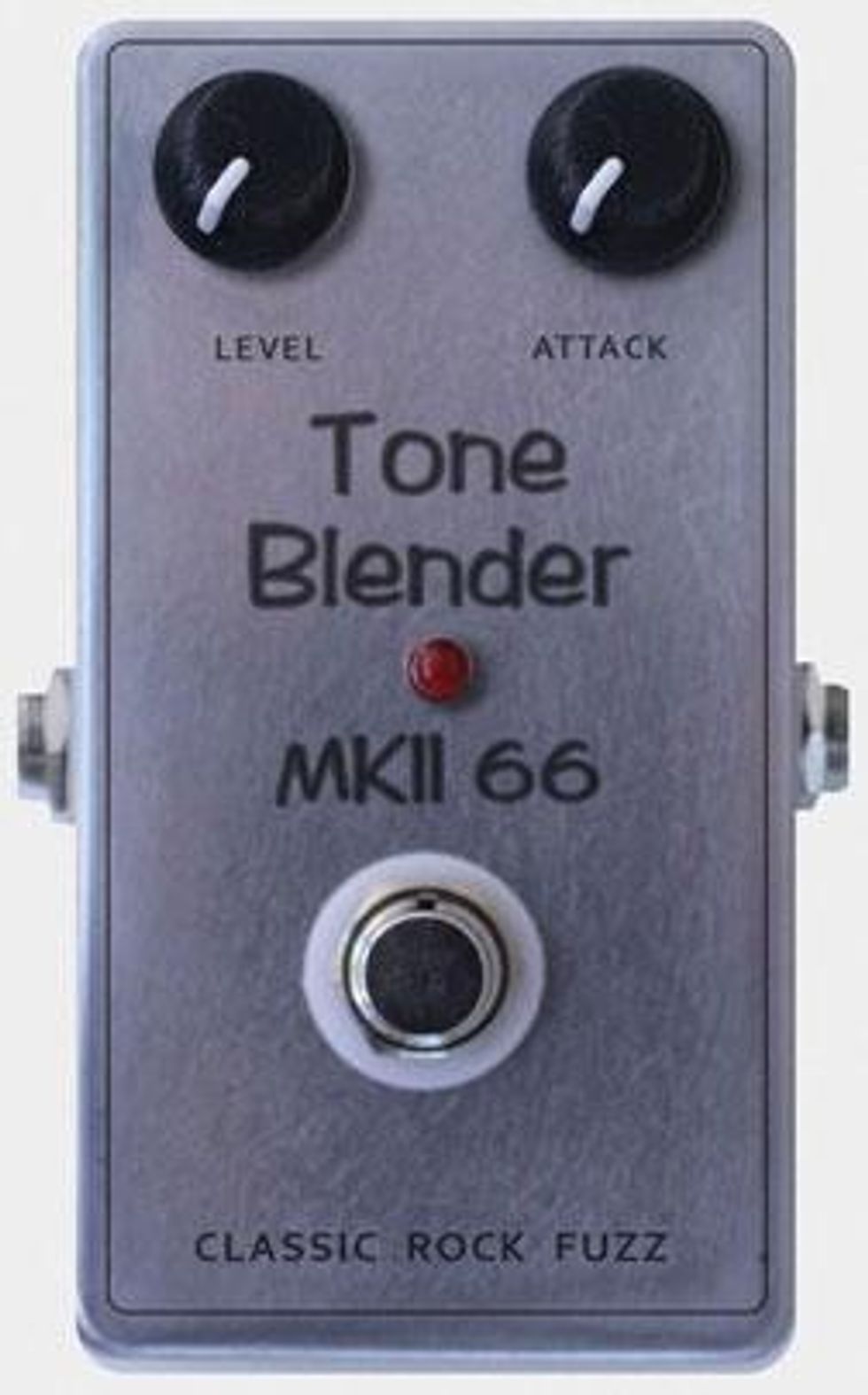
Once you've experienced the rush of hearing a vintage Tone Bender fire up—volume erupting through the roof, mohair-thick fuzz wrapping every note, super-creamy and responsive sustain that gives way to rancorous decay, and subtone artifacts that wobble behind held notes—coveting one is inevitable. Trouble is, a '60s or '70s Bender will set you back $500 to $800. Some clones aren't much cheaper, and most of them tend to sound darker than the originals or lack those artifact surprises. Not so the Tone Blender MkII 66. Big Knob "supreme commander" and one-man band Gary Kibler has been hand-building faithful reproductions of vintage circuits at his workbench for 12 years now, even cutting circuit boards from strip. The MkII is, like its namesake, a three-gain-stage circuit, using Soviet-era military NOS germanium transistors. Level, with unity at, um, barely on, provides a shocking amount of volume on tap, and the attack dial goes from colorful fuzz to hairy, howling banshee. There's no power supply option, in keeping with the originals. You'll want to use your guitar's volume and tone knobs to help command this insane fuzz, which fulfills Kibler's mission to provide classic tones for players on a budget. —TD
The Good: The gory glories of the original MkII Tone Blender at a shocking low price.
The Bad: Also like the originals, you'll need to invest a little time to learn to control this wild, snarling beast—unless you just drop the leash.
$80 street, bigknobpedals.com
Big Knob Tone Blender MkII 66 - Pedals Under $100
Zuzu Green Monster with custom pickup, bridge, in open D tuning; Carr Vincent combo.
Rhythm: clean, Tone Blender volume at unity, attack minimum, then maximum.
Melody line: clean, Tone Blender volume at unity, attack minimum, then maximum, then noon.
- DIY: How to Repair a Wet Pedal - Premier Guitar | The best guitar ›
- Tone Tips: A Crash Course on Buffers - Premier Guitar | The best ›
- Klon vs. Klone: 5 Affordable Stomps Go Head to Head with a Gold ... ›
- Last Call: My Long, Slow Descent Into Pedal Madness | Premier Guitar ›
- GALLERY: 40 Creepy Pedals for Halloween - Premier Guitar | The ... ›
- Using Pedals And Maintaining Good Tone ›
- When Exactly Did "Boutique Pedals" Become a Thing? - Premier ... ›
- Universal Audio Announces UAFX Effects Pedals - Premier Guitar ... ›
- Why Inspiration Is Like Lightning … or Beans - Premier Guitar | The best guitar and bass reviews, videos, and interviews on the web. ›
- When Exactly Did "Boutique Pedals" Become a Thing? - Premier Guitar ›
- Find Your Guitar’s BFF - Premier Guitar ›
- Find Your Guitar’s BFF - Premier Guitar ›
- Tone Tips: Masters of Many - Premier Guitar ›
- Tone Tips: A Crash Course on Buffers - Premier Guitar ›
- Stomp on This - Premier Guitar ›
- Age of Irony: A Day/Year in the Life of PG’s Pedal Issue - Premier Guitar ›
- DIY: How to Repair a Wet Pedal - Premier Guitar ›
- Sailing the Seas of Sound - Premier Guitar ›
- GALLERY: Vintage Electro-Harmonix Pedals - Premier Guitar ›
- GALLERY: Vintage Electro-Harmonix Pedals - Premier Guitar ›
- The Year in Gear—2021 - Premier Guitar ›
- The Stompbox-Builder’s Secret Weapon - Premier Guitar ›
- The Stompbox-Builder’s Secret Weapon - Premier Guitar ›
- The DIY True Bypass Lesson - Premier Guitar ›
- Short on Supplies, Not on Ideas - Premier Guitar ›
- ‘Premier Guitar’ Vs. the Machines - Premier Guitar ›
- ‘Premier Guitar’ Vs. the Machines - Premier Guitar ›
- Like Sands Through the Hourglass - Premier Guitar ›
- Best Distortion Pedals Under $100 - Premier Guitar ›
- Messiah Guitars Introduces Dandelion Fuzz & Quiggly Octofuzz - Premier Guitar ›
- Maestro Mariner Tremolo, Titan Boost, Arcas Compressor Sustainer, Agena Envelope Filter & Orbit Phaser Demos - Premier Guitar ›
- EarthQuaker Devices Life Pedal V3 Review - Premier Guitar ›
- TWA SH9 Scott Henderson Signature Distortion Review - Premier Guitar ›
- Copy of PG Editors on Their Favorite Overdrive/Distortion Pedals - Premier Guitar ›
- Electro-Harmonix Slap-Back Review - Premier Guitar ›
- First Look: Fender Waylon Jennings Phaser - Premier Guitar ›
- Boss Introduces the NS-1X Noise Suppressor Pedal - Premier Guitar ›
- State of the Stomp: Journey to the Center of the Fuzz Face - Premier Guitar ›
- ZeroFive Audio Lowrider Review - Premier Guitar ›
- First Look: Electro-Harmonix Nano Pulsar Stereo Tremolo - Premier Guitar ›
- Trimmer Adjustments Can Twist Funky Pedals Back into Shape - Premier Guitar ›
- Jackson Audio Silvertone Guitar Pedal Review - Premier Guitar ›
See and hear Taylor’s Legacy Collection guitars played by his successor, Andy Powers.
Last year, Taylor Guitars capped its 50th Anniversary by introducing a new guitar collection celebrating the contributions of co-founders Bob Taylor and Kurt Listug to the guitar world. The Legacy Collection revives five of Bob Taylor’s classic acoustic models, curated by the legendary luthier and innovator himself. “To imagine that we’re doing guitars that harken to our past, our present and our future all at the same time,” Bob says, “I really like that.”
In developing the collection, Bob preserved the essence of his originals while integrating performance and playability upgrades introduced during his tenure as designer-in-chief. “It’s an up-to-date version of what those guitars would be,” Bob explains, “but with the same sound.”
Visually, these guitars feel classic—clean, understated and unmistakably Taylor. While Bob’s original aesthetic preferences are showcased in his Legacy models, the nod to the past runs deeper than trade dress.
From his earliest builds, Bob favored slim-profile necks because he found them easier to play. That preference set a design precedent that established Taylor’s reputation for smooth-playing, comfortable necks. Legacy models feature slim mahogany necks built with Taylor's patented New Technology (NT) design. “My first neck was a bolted-on neck but not an NT neck,” Bob says. “These are NT necks because it’s a better neck.” Introduced in 1999, the NT neck allowed for unprecedented micro-adjustability while offering a consistent, hand-friendly Taylor playing experience.
What makes this collection unique within the Taylor line is Bob’s use of his X-bracing architecture, favoring his time-tested internal voicing framework over more recent Taylor bracing innovations to evoke a distinctive tone profile. Since Andy Powers—Taylor’s current Chief Guitar Designer, President and CEO—debuted his patented V-Class bracing in 2018, V-Class has become a staple in Taylor’s premium-performance guitars. Still, Bob’s X-bracing pattern produces a richly textured sound with pleasing volume, balance and clarity that long defined the Taylor voice. All Legacy models feature LR Baggs VTC Element electronics, which Bob says “harkens back to those days.”
The team at Taylor thought the best way to demonstrate the sound of the Legacy guitars was to ask Andy Powers, Bob’s successor, to play them. A world-class luthier and musician, Andy has spent the past 14 years leading Taylor’s guitar innovation. In addition to V-Class bracing, his contributions include the Grand Pacific body style, the ultra-refined Builder’s Edition Collection, and most recently, the stunning Gold Label Collection.
Below you’ll find a series of videos that feature Powers playing each Legacy model along with information about the guitars.
Legacy 800 Series Models
First launched in 1975, the 800 Series was Taylor’s first official guitar series. Today, it remains home to some of the brand’s most acclaimed instruments, including the flagship 814ce, Builder’s Edition 814ce and new Gold Label 814e.
The Legacy 800 Series features the 810e Dreadnought and two Jumbos: the 6-string 815e and 12-string 855e. Each model serves up a refined version of the Dreadnought and Jumbo body shapes Bob inherited from Sam Radding—the original owner of the American Dream music shop where Bob and Kurt first met. “I was making my guitars in the molds that Sam had made at American Dream,” Bob recalls. “There was a Jumbo and a Dreadnought. That’s all we had.”
All three Legacy 800 Series guitars feature one of Bob’s favorite tonewood combos. Solid Indian rosewood back and sides are paired with a Sitka spruce top, yielding warm lows, clear trebles and a scooped midrange.
Aesthetic appointments include a three-ring abalone rosette, mother-of-pearl Large Diamond inlays, white binding around the body and fretboard, and Bob’s “straight-ear” peghead design. Both Jumbo models also showcase a mustache-style ebony bridge—a nod to Bob’s early Jumbo builds.
Legacy 810e

The 810 Dreadnought holds a special place in Bob Taylor’s heart. “My first 810, the one I made for myself, was a thrilling guitar for me to make,” he says. “It’s the one and only guitar I played. It didn’t matter how many guitars we made at Taylor, that’s the one I took out and played.” The Legacy 810e brings back that bold, room-filling Dreadnought voice along with the easy playability expected from a Taylor.
Taylor Guitars | Legacy 810e | Playthrough Demo
Legacy 855e

Taylor’s first 12-strings found an audience in 1970s Los Angeles. “I was making guitars that would find their way to McCabe’s in Santa Monica and Westwood Music,” Bob says, “and these guitars were easy to play. Twelve-strings were a popular sound in that music. It was a modern country/folk/rock music genre that was accepting our guitars because they were easy to play. They also liked the sound of them because our guitars were easier to record.” The Legacy 855e, with its resonant Jumbo body, slim neck and gorgeous octave sparkle, carries that tradition forward.
Taylor Guitars | Legacy 855e | Playthrough Demo
Legacy 815e

The Legacy 815e revives Taylor’s original Jumbo 6-string, delivering a big, lush sound with beautifully blooming overtones.
Legacy Grand Auditoriums
In the early 1990s, Bob Taylor heard a consistent refrain from dealers: “Not everybody wants a dreadnought guitar anymore.” Players were asking for something with comparable volume but different proportions—something more comfortable, yet still powerful. This feedback inspired Bob to design a new body style with more elegant curves, more accommodating proportions and a balanced tonal response. The result was the Grand Auditorium, which Taylor introduced in 1994 to celebrate its 20th anniversary.
Thanks to its musical versatility and easy playability, Bob’s Grand Auditorium attracted a wide variety of players. “We came into our own with our Grand Auditorium,” he says. “People were describing it as ‘all around.’ It’s a good strummer and good for fingerstyle, but it’s not totally geared toward strumming or totally geared toward fingerstyle.” Also referred to as the “Swiss-Army Knife” of guitars or the “Goldilocks” guitar, the GA quickly became a favorite among guitarists across playing styles, musical genres and different playing applications including recording and live performance. “That guitar made studio work successful,” Bob says. It gained a wider fanbase with the debut of the “ce” version, which introduced a Venetian cutaway and onboard electronics. “That became one of our hallmarks,” says Bob. “If you want to plug in your guitar, buy a Taylor.”
Today, the Grand Auditorium is Taylor’s best-selling body shape.
The Legacy Collection features two cedar-top Grand Auditoriums inspired by past favorites: the mahogany/cedar 514ce and rosewood/cedar 714ce. Both models incorporate Bob’s original X-bracing pattern for a tonal character reminiscent of their 1990s and 2000s counterparts. Shared aesthetic details include a green abalone three-ring rosette, ebony bridge pins with green abalone dots, a faux-tortoiseshell pickguard and Taylor gold tuning machines.
Taylor Guitars | Legacy 815e | Playthrough Demo
Legacy 514ce

The Legacy 514ce features solid mahogany back and sides paired with a Western Red cedar top, yielding a punchy midrange and dry, woody sonic personality that pairs beautifully with cedar’s soft-touch sensitivity and warmth. It’s a standout choice for fingerstyle players and light strummers who crave nuance and depth. Distinct visual details include faux-tortoise body and fretboard binding, black-and-white top trim, and mother-of-pearl small diamond fretboard inlays.
Taylor Guitars | Legacy 514ce | Playthrough Demo
Legacy 714ce

The Legacy 714ce also features a cedar top, this time matched with solid Indian rosewood back and sides. The result is a richly textured sound with deep lows, clear trebles and a warm, mellow response. Inspiring as it is, this specific wood pairing isn’t currently offered in any other standard Taylor model. Additional aesthetic details include green abalone dot fretboard inlays, black body and fretboard binding, and black-and-white “pinstripe” body purfling.
While the Legacy Collection spotlights Taylor’s past, newer models from the Gold Label, Builder’s Edition and Somos Collections show the company’s legacy is always evolving. Explore the Legacy Collection at taylorguitars.com or visit your local authorized Taylor dealer.
Taylor Guitars | Legacy 714ce | Playthrough Demo
Detail of Ted’s 1997 National resonator tricone.
What instruments should you bring to an acoustic performance? These days, with sonic innovations and the shifting definition of just what an acoustic performance is, anything goes.
I believe it was Shakespeare who wrote: “To unplug, or not to unplug, that is the question. Whether ’tis nobler in the mind to suffer the slings and arrows of acoustic purists, or to take thy electric guitar in hand to navigate the sea of solo performing.”
Four-hundred-and-twenty-four years later, many of us still sometimes face the dilemma of good William when it comes to playing solo gigs. In a stripped-down setting, where it’s just us and our songs, do we opt to play an acoustic instrument, which might seem more fitting—or at least more common, in the folksinger/troubadour tradition—or do we bring a comfy electric for accompaniment?
For me, and likely many of you, it depends. If I’m playing one or two songs in a coffeehouse-like atmosphere, I’m likely to bring an acoustic. But if I’m doing a quick solo pop up, say, as a buffer between bands in a rock room, I’m bringing my electric. And when I’m doing a solo concert, where I’ll be stretching out for at least an hour, it’s a hybrid rig. I’ll bring my battered old Guild D25C, a National tricone resonator, and my faithful Zuzu electric with coil-splitting, and likely my gig pedalboard, or at least a digital delay. And each guitar is in a different tuning. Be prepared, as the Boy Scouts motto states. (For the record, I never made it past Webelos.)
My point is, the definition of the “acoustic” or “coffeehouse” performance has changed. Sure, there are still a few Alan Lomax types out there who will complain that an electric guitar or band is too loud, but they are the last vestiges of the folk police. And, well, acoustic guitar amplification is so good these days that I’ve been at shows where each strum of a flattop box has threatened to take my head off. My band Coyote Motel even plays Nashville’s hallowed songwriter room the Bluebird Café as a fully electric five-piece. What’s key, besides a smart, flexible sound engineer, is controlling volume, and with a Cali76 compressor or an MXR Duke of Tone, I can get the drive and sustain I need at a low level.
“My point is, the definition of the ‘acoustic’ or ‘coffeehouse’ performance has changed.”
So, today I think the instruments that are right for “acoustic” gigs are whatever makes you happiest. Left to my own devices, I like my Guild for songs that have a strong basis in folk or country writing, my National for blues and slide, and my electric for whenever I feel like adding a little sonic sauce or showing off a bit, since I have a fluid fingerpicking hand that can add some flash to accompaniment and solos. It’s really a matter of what instrument or instruments make you most comfortable because we should all be happy and comfortable onstage—whether that stage is in an arena or theater, a club or coffeehouse, or a church basement.
At this point, with instruments like Fender’s Acoustasonic line, or piezo-equipped models from Godin, PRS, and others, and the innovative L.R. Baggs AEG-1, it’s worth considering just what exactly makes a guitar acoustic. Is it sound? In which case there’s a wide-open playing field. Or is it a variation on the classic open-bodied instrument that uses a soundhole to move air? And if we arrive at the same end, do the means matter? There is excellent craftsmanship available today throughout the entire guitar spectrum, including foreign-built models, so maybe we can finally put the concerns of Shakespeare to rest and accept that “acoustic” has simply come to mean “low volume.”
Another reason I’m thinking out loud about this is because this is our annual acoustic issue. And so we’re featuring Jason Isbell, on the heels of his solo acoustic album, a piece on how acoustic guitars do their work authored by none other than Lloyd Baggs, and Andy Fairweather Low, whose new solo album—and illustrious career—includes exceptional acoustic performances. If you’re not familiar with his work, and you are, even if you don’t know it, he was the gent sitting next to Clapton for the historic 1992 Unplugged concert—and lots more. There are also reviews of new instruments from Taylor, Martin, and Godin that fit the classic acoustic profile, so dig in, and to heck with the slings and arrows!Ernie Ball, the world’s leading manufacturer of premium guitar strings and accessories, proudly announces the launch of the all-new Earthwood Bell Bronze acoustic guitar strings. Developed in close collaboration with Grammy Award-winning guitarist JohnMayer, Bell Bronze strings are engineered to meet Mayer’s exacting performance standards, offering players a bold new voice for their acoustic guitars.Crafted using a proprietary alloy inspired by the metals traditionally found in bells and cymbals, Earthwood Bell Bronze strings deliver a uniquely rich, full-bodied tone with enhanced clarity, harmonic content, and projection—making them the most sonically complex acoustic strings in the Ernie Ball lineup to date.

“Earthwood Bell Bronze strings are a giant leap forward in tone, playability, and durability. They’re great in any musical setting but really shine when played solo. There’s an orchestral quality to them.” -John Mayer
Product Features:
- Developed in collaboration with John Mayer
- Big, bold sound
- Inspired by alloys used for bells and cymbals
- Increased resonance with improved projection and sustain
- Patent-pending alloy unique to Ernie Ball stringsHow is Bell Bronze different?
- Richer and fuller sound than 80/20 and Phosphor Bronze without sounding dark
- Similar top end to 80/20 Bronze with richer low end than Phosphor Bronze
The Irish post-punk band’s three guitarists go for Fairlane, Fenders, and a fake on their spring American tour.
We caught up with guitarists Carlos O’Connell and Conor Curley from red-hot Dublin indie rock outfit Fontaines D.C. for a Rig Rundown in 2023, but we felt bad missing bassist Conor “Deego” Deegan III, so we’ve been waiting for the lads to make their way back.
This time, riding the success of their fourth LP, 2024’s Romance, we caught up with all three of them at Nashville’s Marathon Music Works ahead of their April 30 gig to see what they brought across the pond.
Brought to you by D’Addario
All’s Fairlane

Curley’s go-to is this Fairlane Zephyr, loaded with Monty’s P-90s and a Mastery bridge. It mostly stays in standard tuning and, like his other axes, has Ernie Ball Burly Slinky strings.
Blue Boy
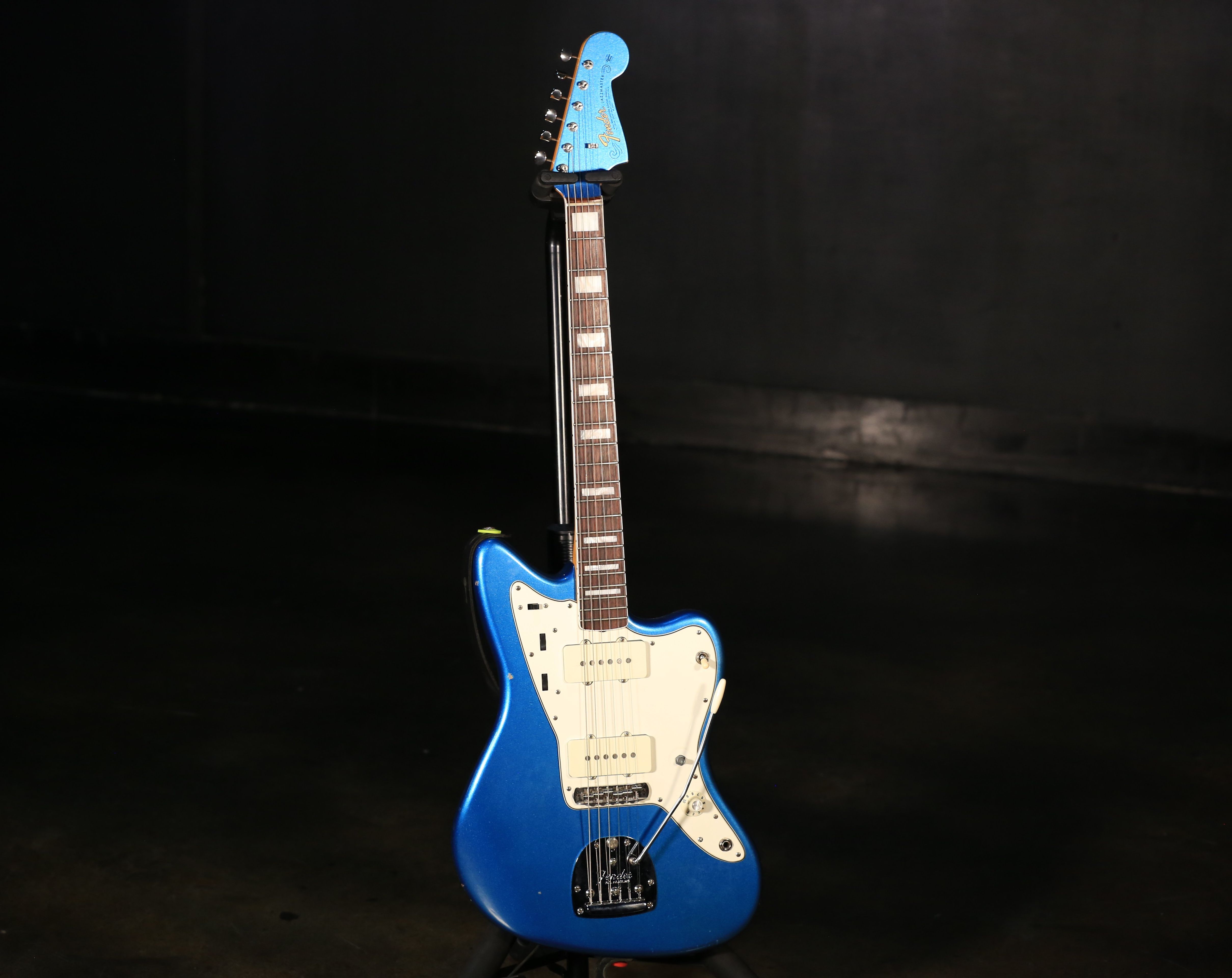
Fender sent Curley this Jazzmaster a couple of years ago, and since then, he’s turned to it for heavier, more driven sounds. It’s tuned to E flat, but Curley also tunes it to a unique shoegaze-y tuning for their tune “Sundowner.”
You can also catch Curley playing a Fender Johnny Marr Jaguar.
Twin Win
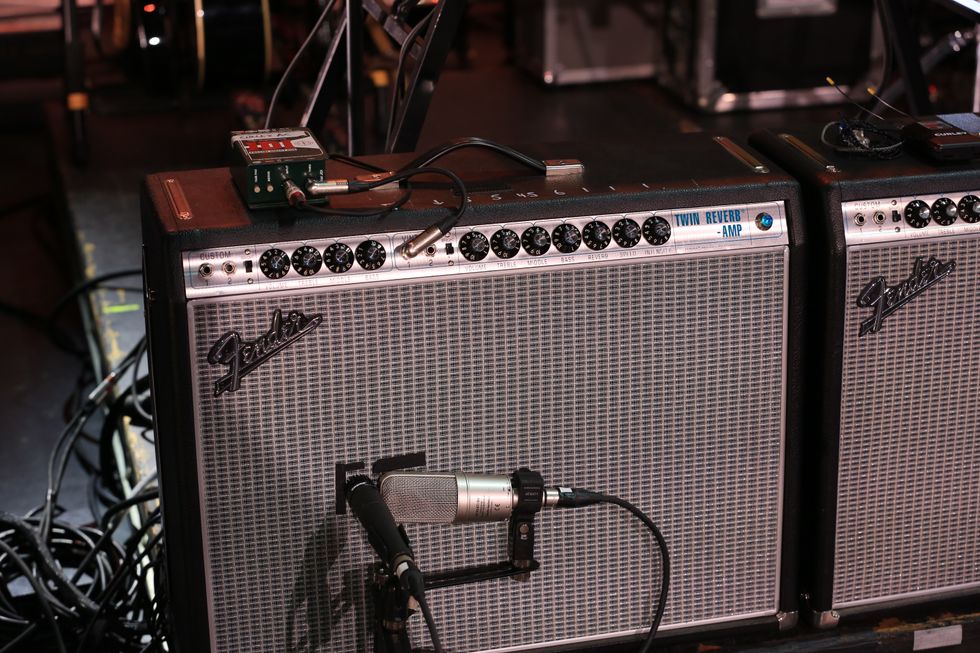
Fender Twin Reverbs are where Conor Curley feels most comfortable, so they’re his go-to backline. The amps are EQ’d fairly flat to operate as pedal platforms.
Conor Curley’s Pedalboard
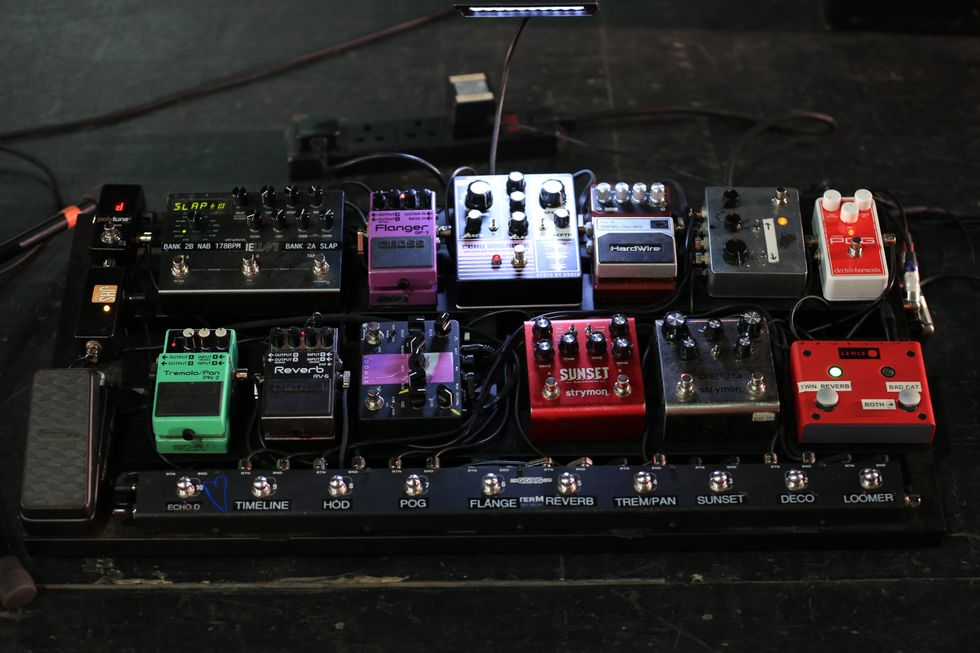
Curley’s pedalboard for this tour includes a TC Electronic PolyTune3 Noir, Strymon Timeline, Boss RV-6, Boss PN-2, Boss BF-3, Keeley Loomer, Death by Audio Echo Dream, Fairfield Circuitry Hors d'Ouevre?, Strymon Sunset, Strymon Deco, DigiTech Hardwire RV-7, Electro-Harmonix Nano POG, and Lehle Little Dual.
Fake Out
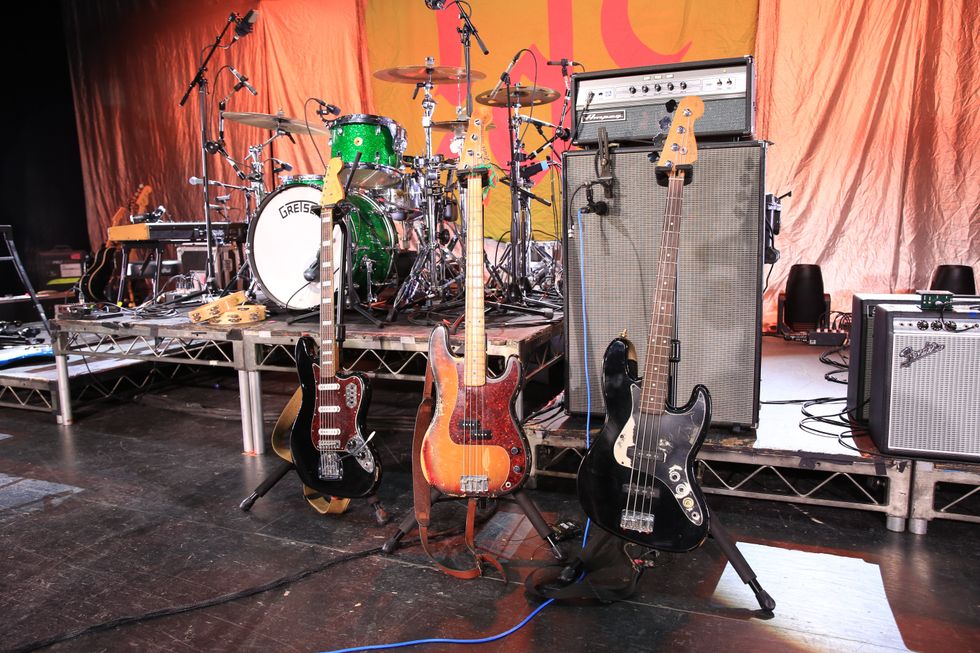
Connor Deegan didn’t own a bass when Fontaines D.C. began, and his first purchase was the black Fender Jazz bass (right)—or so he thought. He later discovered it was a total knock-off, with a China-made body, Mexico-made neck, and a serial number that belongs to a Jaguar. But he fell in love with it, and its sound—nasal on the high strings, with cheap high-output pickups—is all over the band’s first record, Dogrel. Deego plays with orange Dunlop .60 mm picks, and uses Rotosound Swing Bass 66 strings.
Deegan picked up the Squier Bass VI (left) for its “surfy vibes,” and upgraded the pickups and bridge.
Also in his arsenal is this 1972 Fender P-bass (middle). (He’s a bit nervous to check the serial number.)
V-4 You Go
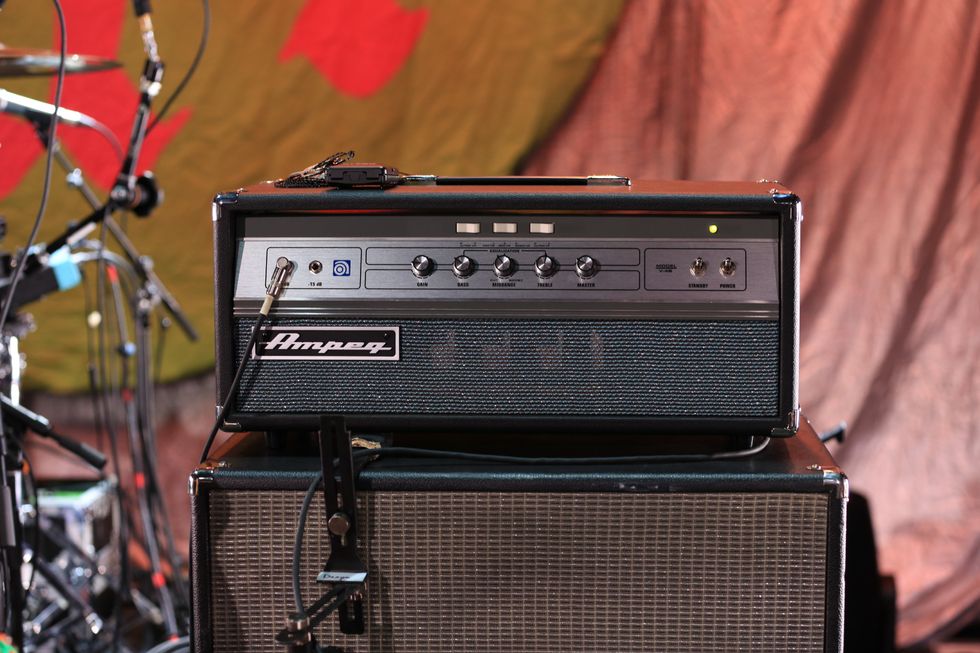
Deego plays through an Ampeg V-4B head into a Fender 6x10 cabinet.
Conor Deegan’s Pedalboard
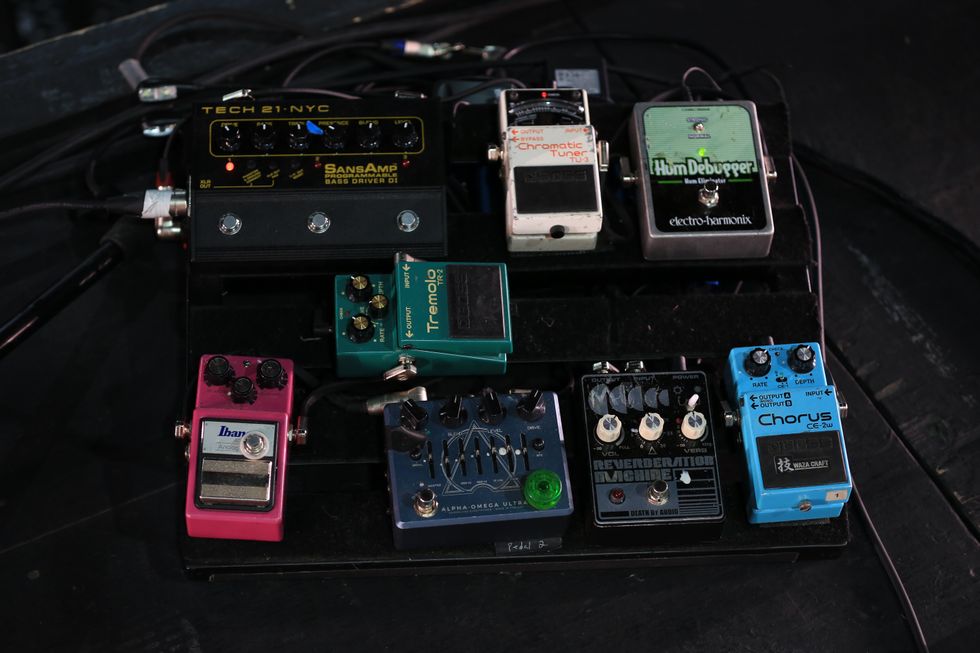
Deegan’s board includes a Boss TU-3, Electro-Harmonix Hum Debugger, Boss TR-2, modded Ibanez Analog Delay, Death by Audio Reverberation Machine, Boss CE-2w, Tech 21 SansAmp Bass Driver DI, Darkglass Electronics Alpha Omega Ultra, and Dunlop Volume (X) Mini pedal. A GigRig QuarterMaster helps him switch sounds.
Mustang Muscle
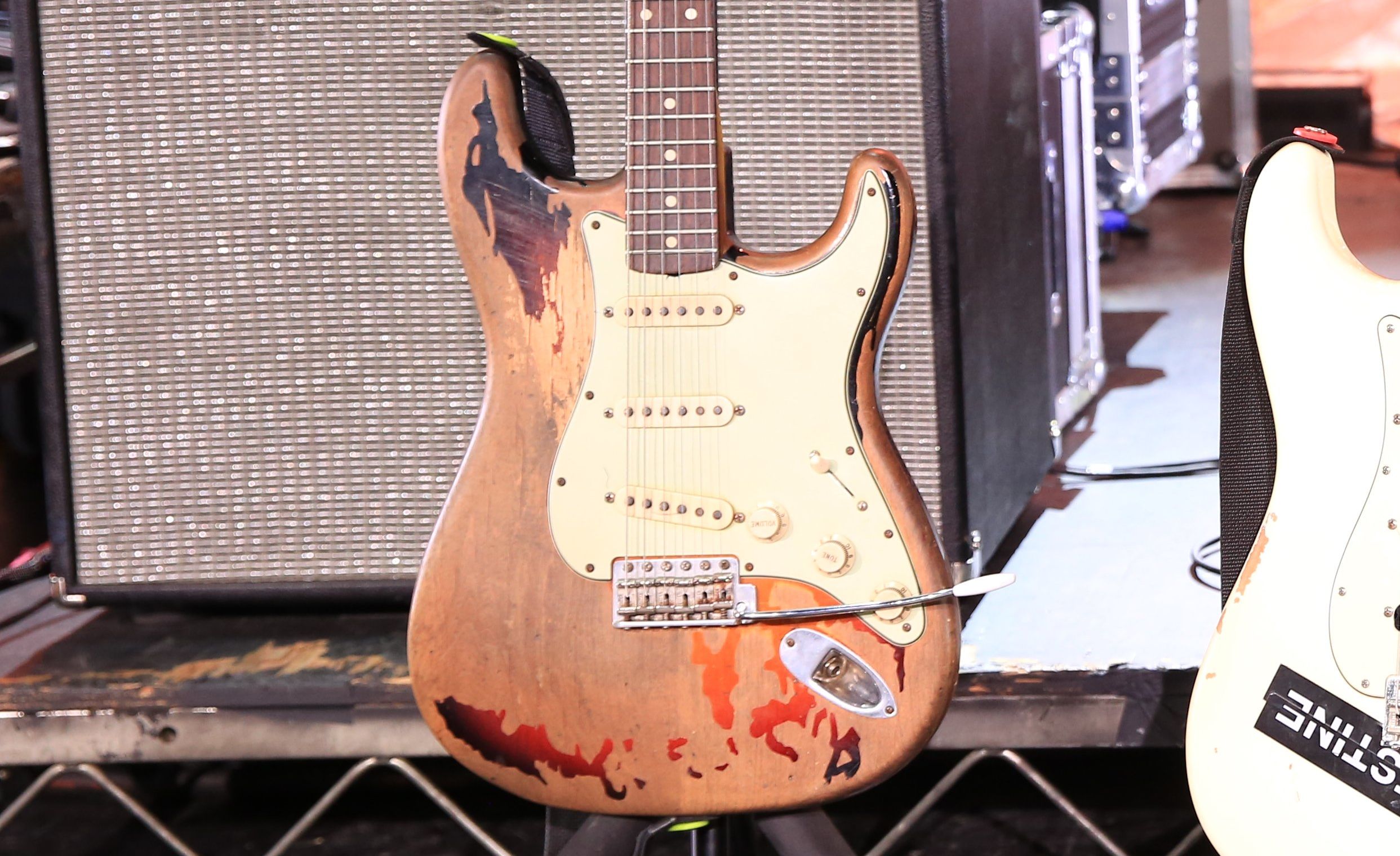
Carlos O’Connell favors this 1964 Fender Mustang, which has been upgraded with a Seymour Duncan Hot Rails pickup since Romance. It’s set up so that the single-coil pickup is always on, and he’ll add in the Hot Rails signal for particular moments.
Ghost of Gallagher
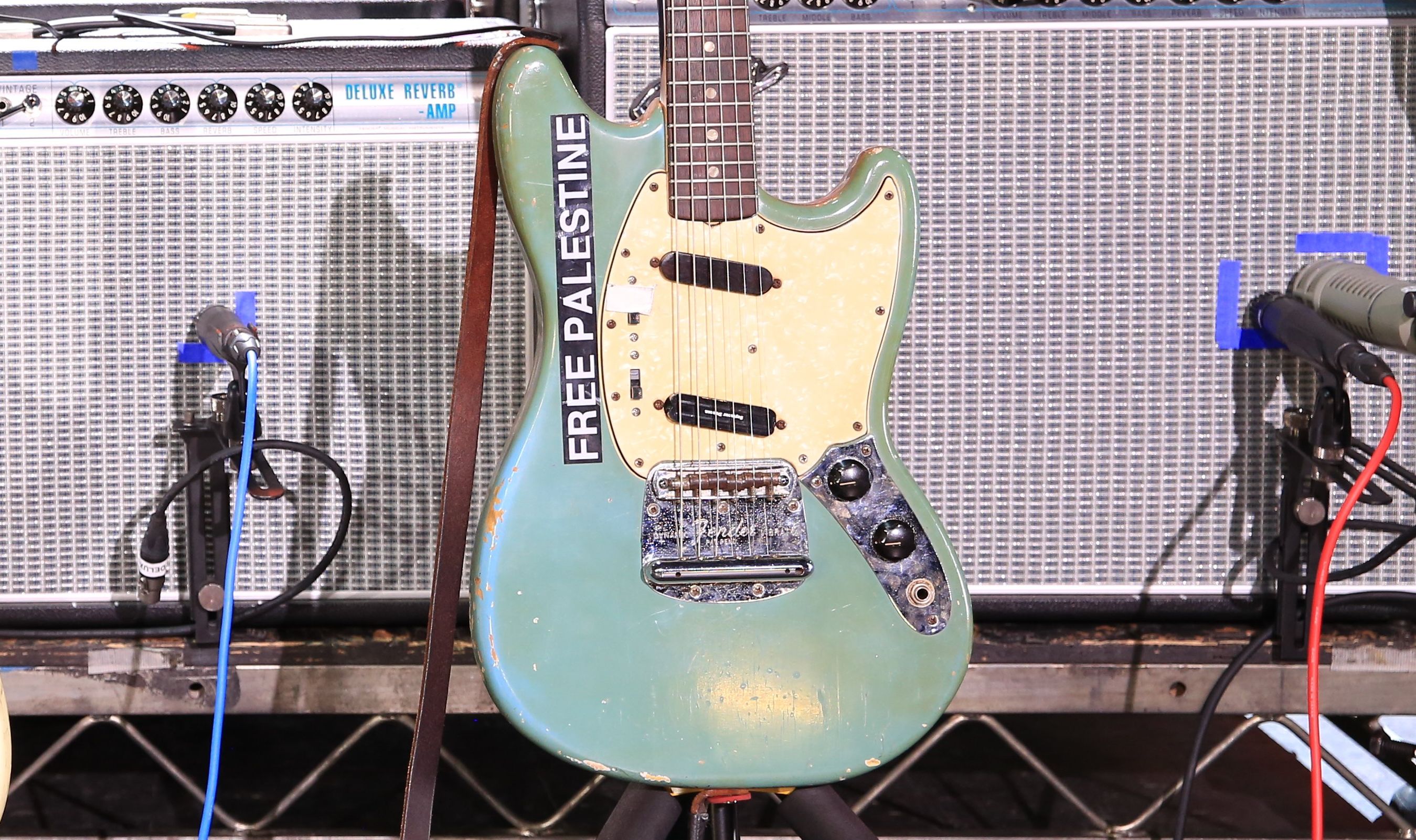 Mustang Muscle
Mustang MuscleAfter getting to play a number of Rory Gallagher’s guitars thanks to a private invitation from the guitarist’s estate, O’Connell picked up this Fender Custom Shop Rory Gallagher Signature Stratocaster. The jangly, direct tone of this one is all over tunes like “Boys in the Better Land.”
More Fender Friends
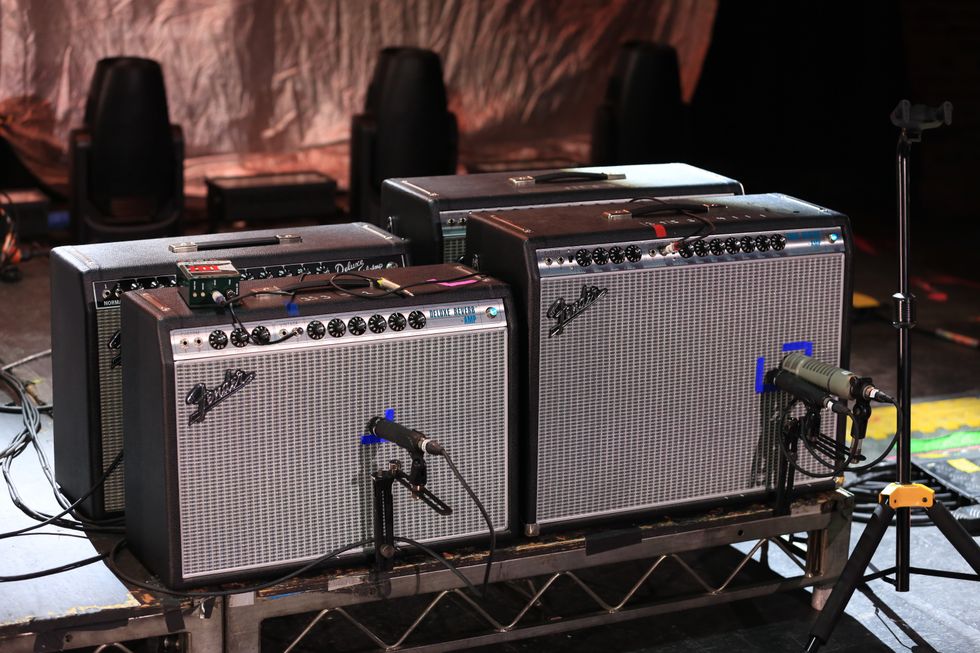
O’Connell runs his guitars, including a vintage Martin acoustic which he picked up in Nashville, through a Fender Twin Reverb and Deluxe Reverb.
Carlos O’Connell’s Pedalboard
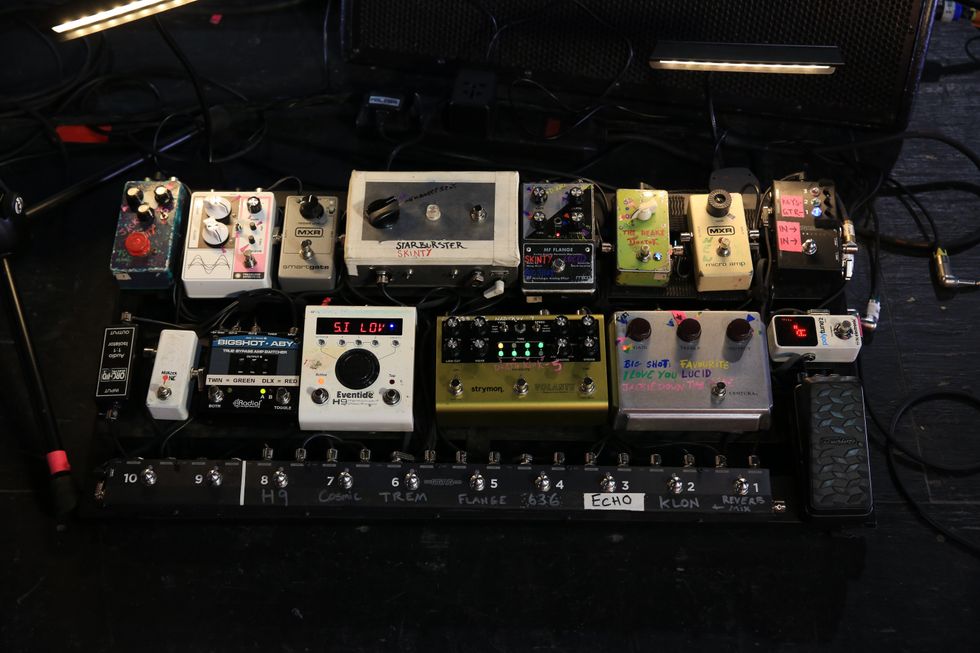
The gem of O’Connell’s board is this Soundgas 636p, an imitation of the infamous Grampian 636 mic preamp’s breakup. Alongside it are a TC Electronic PolyTune, Ceriatone Centura, Strymon Volante, Eventide H9, Orchid Electronics Audio 1:1 Isolator, Vein-Tap Murder One, MXR Micro Amp, Moog MF Flange, MXR Smart Gate, and Freqscene Koldwave Analog Chorus. A Radial BigShot ABY navigates between the Twin and Deluxe Reverb.
